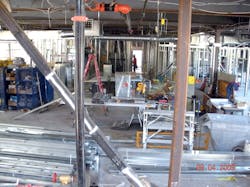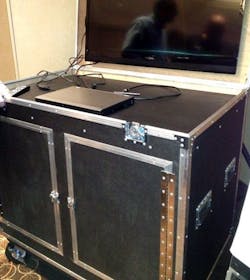Walk onto many job sites, and it’s not uncommon to see extreme clutter everywhere (Photo 1) — and the same goes for gang boxes (Photo 2). According to in-house research from MCA, up to 5% of an electrical laborer’s time could be spent looking for tools and materials on the job site. Those lost man-hours in retrieving, handling, moving, and storing tools/materials can be extremely expensive. In fact, the cost of labor spent on material handling could be as high as 40% of the total labor used, depending on the job.
The bottom line is that activities related to gang box management — or the lack thereof — are taking precious time away from the electrical installer while he looks for the gang box, walks to and from the gang box, looks for materials/tools inside the box, sorts/organizes it, or moves the gang box to, from, or around the job site. These events take place because the gang box is not designed as part of the means to delivering installation. By failing to plan appropriately up-front and simply using the gang box as a “storage refuge,” tradesmen are not supported effectively — and the larger the job gets, the more expensive the problem becomes.
The good news is a better way exists to manage gang boxes. Let’s focus on the following four categories and identify areas where you can see the most improvement: content management, location management, replenishment process, and vendor management.
Content management — Although every job is different, many of the core tasks remain the same, because all buildings have comparable phases of work, such as site-work, layout, rough-in, finish, trim, inspection, commissioning, etc. From an efficiency standpoint, the content of the gang boxes should change as the job progresses and match the current phase of construction. The Table shows a sample of a tool listing by work segment of the project based on when they will occur.
You can accomplish this by first creating a job phase breakdown of the project. Next, create a checklist of content for various phases of the job. Identify how many gang boxes for material and tools you would need, and determine what time you will need them. Then, develop a plan for how to move gang boxes in and out of specific areas as the different phases of work progress.
Location management — Location on any job site is at a premium, especially as the project comes to a close. Knowing the available locations and times they are accessible is one of the most important pieces of information you can have for proper material handling and reduction of labor cost. Locating gang boxes too far from the point of installation, for example, could end up being very expensive.
Consider the following scenario: If your worker has to walk back and forth four times a day and waste 10 minutes each way doing so, that cost can add up very quickly. At $50 per hour, that equals $33 per day. If the job lasts 100 working days, that statistic translates into $3,300 per person wasted on just moving back and forth from the work area to the improperly located gang box. To reduce this cost, you must map out the job layout and phase breakdown of the project from the beginning.
At the start of the job, review the physical layout of the project. Next, identify the best places you can locate your gang boxes. Check the distance from your ultimate work area, and find any way possible to reduce it. For large tools, try to co-locate them to reduce the cost of transportation and increase their usage efficiency. If allowed, move the gang box to different locations as the job progresses, each time placing it as close as possible to the point of installation. Also, keep in mind the cost of additional gang boxes may easily offset the wasted labor cost of workers walking to and from boxes located a greater distance from the work area.
Replenishment process — An empty gang box is a useless gang box. An out-of-sequence gang box is an even greater waste of labor. Planning, scheduling, tracking, and upkeep of the gang box’s contents and location can save up to 5% of the laborer’s time. For example, on a 1,000-hour job, using a labor rate of $50/hour, this equates to $2,500.
Creating a checklist at the beginning of the job that matches the job’s work breakdown structure will help you plan and schedule for gang box replenishment. If the gang boxes can be marked as to which phase they belong, a material handler can visit the site, collect the gang boxes that are no longer needed, and bring in the new ones. Material for the exchange can also be brought to the site and changed out. Yes, it seems that some material will be wasted; and yes, it is true that there may be something in that gang box your workers could need for the next phase of the project. However, the cost of buying new items at that point will be cheaper than fumbling around in a gang box that no longer matches the work tasks being performed.
Vendor management — As an electrical contractor, you’re in the business of installing and repairing electrical equipment. On the other hand, manufacturers and distributors are in the business of material supply, handling, and logistics management. You may ask yourself, why do I want to do their job if they can do it for me in a more efficient manner?
Even if you have to pay a bit extra for their services, their process and labor costs might be lower than yours. In addition, it could help you reduce the cost of inspection, which typically adds another 5% to your labor. You should also ask them if they do consignment (e.g., pay as you use). Your vendors can use your content, location, and replenishment process to deliver your gang boxes and tools where, when, and how you want them.
If you decide to work with a vendor to manage your gang boxes, make sure you provide them with the following items prior to starting the job: bill of material (BOM) for your gang boxes, list of the tools they can handle for you, content list and job phase schedule, job location layout, and replenishment schedule (make sure you update them as needed). Once the job is underway, you should perform spot checks for correctness of their work.
Another issue to keep in mind is the subject of material returns. Obviously, the best return is no return, but that’s simply not realistic. If you can reduce the amount you return below 3% of the total material cost, your labor cost will go down. The gang boxes you use are no exception to this rule; they have to go back, too.
The cheapest way of returning material is to employ a return-as-you-go approach. To do this, you need to follow the same plan you have for delivery replenishment, but in reverse. So have a schedule for the returns as the job progresses, and realize the need for different material in your gang boxes changes. A good solution is to have a gang box on-site dedicated to “returns only.” This makes it easier for your material handler or vendor to quickly identify what needs to go back while your electricians remain focused on their work when the truck arrives.
Daneshgari is president and CEO of MCA, Inc., Flint, Mich. Moore is vice president of operations. They can be reached at [email protected] and [email protected].
SIDEBAR: Gang Box of the Future
Gang boxes of the future are going to be more of an information management center than just a pile of tools and materials. The Photo shows an example of a much more modern gang box, implemented by F.B. Harding, an electrical contractor in Baltimore, Md., on a data center project in Rockville, Md. The usage of work packages and BIM, as well as on-time schedule and productivity tracking tools, can be instantaneously monitored by the foreman at any location of the job. Allowing the foreman to have the latest information about the job at his fingertips, this type of setup prevents him from having to track down prints or other information about the job (such as CAD or BIM layouts) in hard copy form, which ultimately saves time and money.







